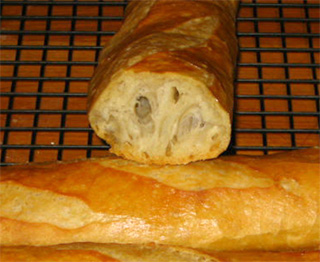I like me baguette to be thin crunchy crush and soft, light, and chewy in the center. I follow exactly Schimpf's recipe just some add some additional ingredients. I add 1 teaspoon Malt Power and 1 tablet Vitamin C in the bread dough, and brush the eggs wash or melted butter and spray salt water before baking. I also bake only 13-15 minutes instead of 20-25 minutes.
Starter - Poolish:
All purpose flour - 100 grams (3.52oz - fair 2/3 cup)
Warm Water (100F-110F) - 100 grams (3.52oz = less than 1/2 cup)
Yeast - pinch (0.5 grams)
Poolish
Bread flour 375 grams ( 13.23 oz = 0.827 pound)
Water - 225 grams (7.595 oz = = 0.949 cup)Yeast 1 grams
Salt 10 grams (0.353 oz = 1.645 teaspoon)
1 tablet Vitamin C (if use 1 tsp syrup mix with the ingredient's water, tablet mash to powder)
Final Dough Percentages
Flour - 475 grams (1.047 pound) - 100%
Water - 325 grams (10.97 ounce ) - 68.4%
Yeast - 1.5 - 0.3 %
Salt - 10 grams (1.64 tsp) - 2.1 %
1) Mixing Dough:
Whisk it around; it’ll soften, but not fully dissolve. |
Next day, place the starter, flour, Vitamin C, salt, soft butter, and yeast mixture in a mixing bowl (or bread machine bucket). |
| If you’re using a stand mixer, knead briefly with the beater, just till the dough becomes cohesive, same with knead by hand and let stand for 10-30 minutes. Then knead about 1-2 minutes |
3) 1st Fermenting:
Look how lovely and elastic it is, too. If you’d kneaded it fully at first, it wouldn’t stretch like this. |
- The process of misting and loosely reapplying the plastic wrap may be repeated once or twice during the final proofing, depending on the humidity level in the kitchen and the length of time required to reach the size desired for baking.
5) Folding and Forming the baguette: The process of folding the dough and pressing the ends together should only be done twice. First, we want a tight or stretched outer crown to the loaf during final proofing. Second, we want to minimize handling so as to not degas the loaf after the primary fermentation.
After 15 minutes, flatten one piece of dough into a rough rectangle. |
Fold it over… |
…and seal the edge with your fingers. |
Flatten again…
|
Use a razor blade or other very sharp blade to make three diagonal slashes in each baguette. Hold the sharp knife at a 45° angle to the bread, be quick, and use firm strokes. |
Brush egg wash or melted butter and spray salt water, |
Immediately prior to loading the loaves to the oven and bake for 13-15 minutes. Gently turn (you may have to pry it free just a tad) the loaves bottom side up in the pan to promote even crisping and browning. Bake for about 5 minutes, during which you can even rotate the loaves so that the sides brown and crisp too, or until the loaves are crisp all over. |


No comments:
Post a Comment